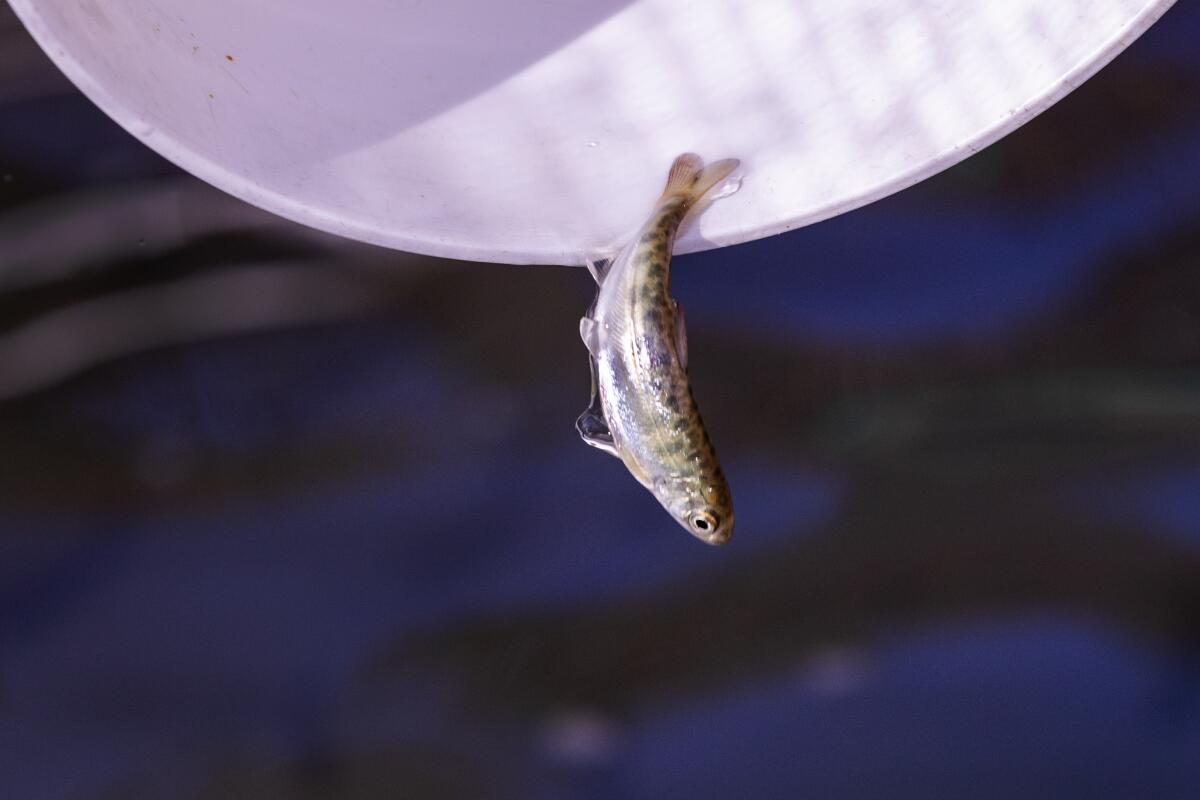Wildlife officials truck Chinook salmon to cooler waters in emergency move to help them spawn

In a stopgap measure to help struggling spring- and winter-run Chinook salmon spawn in the face of rising water temperatures and lower water levels due to climate change, state and federal wildlife officials in Northern California have begun trucking adult fish to cooler waters.
The spring- and winter-run salmon are genetically different, with the seasonal labels marking when adult fish travel from the Pacific Ocean back to the Sacramento River to spawn.
The spring-run Chinook, listed as threatened under the Endangered Species Act, are being moved from traps at the base of Keswick Dam to Clear Creek in the Sacramento River.
About 300 specimens of the winter-run salmon, listed as endangered since 1994, are being moved from a government-run hatchery to waters above the Eagle Canyon Dam on the North Fork of Battle Creek, east of Redding. The relocation, which began with a single fish, marks the first time in more than 110 years that the winter-run salmon have occupied those waters.
“It’s just beautiful, cool, shady habitat for them,” said Peter Tira, a spokesman for the California Department of Fish and Wildlife. “While they can’t physically access it because of the barriers, their offspring will be able to just kind of ride the waterfalls down and will be able to make their migration to the ocean.”
As dams and global warming push endangered California salmon to the brink, a rescue plan is taking shape — and a tribe pushes for recovering their sacred fish.
The efforts, which began last month, are short-term, emergency measures, especially for the winter-run salmon, Tira said.
“This is the third year of drought, and these fish have a three-year life cycle, basically,” he said. “And we’ve had two years of poor production, so we can’t afford to have another year of poor production.”
Since 1997, the U.S. Fish and Wildlife Service has operated the Livingston Stone National Fish Hatchery to produce winter-run Chinook, and production is expected to be expanded in another attempt to bolster the population.
The efforts are temporary until a permanent solution for the fish to reach areas above Shasta Lake can be found. One proposal would see fish trucked directly to the McCloud River, above the Shasta Dam, to spawn. Their offspring would then be trapped and trucked down to the Sacramento River to begin their journey to the Pacific.
The building of dams such as Eagle Canyon and nearby Shasta, as well as Pacific Gas & Electric facilities, have blocked the salmon from reaching their natural spawning habitats fed by colder waters.
The winter-run salmon, for example, have been unable to reach areas like the McCloud River, which are fed by cold springs.
The fire swept through an upscale neighborhood on May 11, spurred by robust coastal winds and dry brush starved of moisture due to a drought gripping the West.
Instead, the fish have been forced to lay their eggs at the base of Shasta Lake in the shallowing Sacramento River. And the drought and rising temperatures have heated water fed from Shasta Lake to the river.
The high temperatures are lethal for winter-run salmon eggs; last year, state biologists estimated, less than 3% of the eggs hatched.
With warming waters wreaking havoc on the spawning of Chinook salmon, the government’s plans for reintroducing the fish to cooler habitats have raised concerns among members of the Winnemem Wintu Tribe, whose ancestors were displaced by the Shasta Dam and for whom salmon are central to cultural and spiritual traditions.
Instead of releasing hatchery-raised fish, the tribe wants to use salmon that once lived in the Sacramento River but were transplanted to New Zealand more than a century ago.
“There is nobody else who is more supportive of bringing fish back to that river than the Winnemem are,” Caleen Sisk, chief and spiritual leader of the Winnemem Wintu Tribe, recently told The Times. “But if you’re going to bring hatchery fish, then we will oppose it.”
Rather than hauling salmon in trucks, tribal leaders want to develop a way for the fish to move naturally upriver, past the dam, to Shasta Lake.
Years ago, the tribe developed a reintroduction proposal for a swimway with a holding pool, pumps and a pipe system that would allow fish to swim upstream, exiting through a floating structure in the reservoir.
More to Read
Sign up for Essential California
The most important California stories and recommendations in your inbox every morning.
You may occasionally receive promotional content from the Los Angeles Times.













